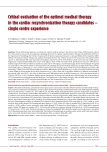Normal pulmonary circulation pressure values in healthy subjects at rest and during exercise
Authors:
J. Widimský
Authors‘ workplace:
Klinika kardiologie IKEM Praha, přednosta prof. MUDr. Jan Kautzner, CSc., FESC
Published in:
Vnitř Lék 2011; 57(10): 815-818
Category:
Original Contributions
Overview
The paper is based on the results of an earlier retrospective international WHO study of normal pressure values in the pulmonary circulation and the right heart in 468 healthy individuals. The results of this study suggest that the pulmonary hypertension should be defined by the mean pulmonary artery pressure at rest of ≥ 20 mmHg and not ≥ 25 mmHg. Pulmonary wedge pressure should be < 12 mmHg. These results have recently been confirmed by the so far largest retrospective international study of normal values published by Kovacs et al and involving 1187 healthy volunteers. However, this study does not include pulmonary wedge pressure values. Normal values of the mean pulmonary artery pressure during exercise are determined by age. In healthy individuals younger than 50 years of age, the mean pulmonary artery pressure during exercise increases in parallel with increasing cardiac output. However, the increase in the mean pulmonary artery pressure during exercise is steeper in healthy individuals aged 50 years and over. This results from a sharper increase in the pulmonary wedge pressure caused probably by diastolic dysfunction of the left ventricle in the older population.
Key words:
pulmonary artery pressures – mean pulmonary artery pressure – wedge pressure – age – exercise
Sources
1. Barst RJ, Gibbs JS, Ghofrani HA et al. Update evidence-based treatment algorithm in pulmonary arterial hypertension. J Am Coll Cardiol 2009; 54 (1 Suppl): S78–S84.
2. Galiè N, Hoeper MM, Humbert M et al. ESC Committee for Practice Guidelines (CPG). Guidelines for the diagnosis and treatment of pulmonary hypertension: the Task Force for the Diagnosis and Treatment of Pulmonary Hypertension of the European Society of Cardiology (ESC) and the European Respiratory Society (ERS), endorsed by the International Society of Heart and Lung Transplantation (ISHLT). Eur Heart J 2009; 30: 2493–2537.
3. Widimský J, Dixon H. Normal values of central haemodynamics at rest and during exercise. A preliminary report of a retrospective WHO study. In: Rulli V, Messin R, Denolin H (eds). Normal values in adults ergometry according to age, sex and training. Symposium of the Working Group on Physiology and Electrocardiography of Exercise. Roma 1980: Proceedings Eur Soc Cardiol 1981; 177–195.
4. Kovacs G, Berghold A, Scheidl S et al. Pulmonary arterial pressure during rest and during exercise in healthy subjects: a systematic review. Eur Respiration J 2009; 34: 888–894.
5. Ouředník A, Susa Z. How long does the pulmonary hypertension last in chronic obstructive bronchopulmonary disease? In: Widimský J (ed.). Progress in respiratory research. Vol. 9: Pulmonary Hypertension. Basel: S. Karger 1975; 9: 24–28.
6. Weitzenblum E, Hirth C, Ducolone A et al. Prognostic value of pulmonary artery pressure in chronic obstructive pulmonary disease. Thorax 1981; 36: 752–758.
7. Jandová R, Widimský J, Nikodýmová. Long-term prognosis of pulmonary hypertension in chronic lung diseases. In: Widimský J, Herget J, Mlczoch J (eds). Pulmonary circulation in chronic pulmonary diseases. Selected papers of the International Symposium on Pulmonary Circulation IV. Prague. Basel: S. Karger. Progr Respir Res 1985; 20: 157–169.
8. Widimský J. Plicní hypertenze u chronických plicních onemocnění. Cor Vasa 2007; 49: 25–34.
Labels
Diabetology Endocrinology Internal medicineArticle was published in
Internal Medicine

2011 Issue 10
Most read in this issue
- Normal pulmonary circulation pressure values in healthy subjects at rest and during exercise
- Treatment of acute exacerbation of the obstructive pulmonary disease with hospitalization at an Intensive Care Unit.
- Resynchronization therapy for heart failure – still many question marks
- Prognostic markers in chronic lymphocytic leukemia
